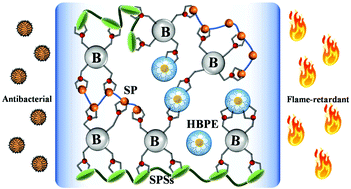当前位置:
X-MOL 学术
›
Green Chem.
›
论文详情
Our official English website, www.x-mol.net, welcomes your
feedback! (Note: you will need to create a separate account there.)
Borate chemistry inspired by cell walls converts soy protein into high-strength, antibacterial, flame-retardant adhesive
Green Chemistry ( IF 9.3 ) Pub Date : 2020/01/27 , DOI: 10.1039/c9gc03875b Weidong Gu 1, 2, 3, 4, 5 , Feng Li 2, 3, 4, 5 , Xiaorong Liu 2, 3, 4, 5 , Qiang Gao 2, 3, 4, 5 , Shanshan Gong 2, 3, 4, 5 , Jianzhang Li 1, 2, 3, 4, 5 , Sheldon Q. Shi 1, 2, 3, 4, 5
Green Chemistry ( IF 9.3 ) Pub Date : 2020/01/27 , DOI: 10.1039/c9gc03875b Weidong Gu 1, 2, 3, 4, 5 , Feng Li 2, 3, 4, 5 , Xiaorong Liu 2, 3, 4, 5 , Qiang Gao 2, 3, 4, 5 , Shanshan Gong 2, 3, 4, 5 , Jianzhang Li 1, 2, 3, 4, 5 , Sheldon Q. Shi 1, 2, 3, 4, 5
Affiliation

|
Urea formaldehyde, phenolic, and melamine formaldehyde resins are currently the most common wood adhesives. However, these modern wood adhesives have toxicity problems and most of the raw materials come from non-renewable resources. Ideally, future alternative adhesives will be prepared from non-toxic, inexpensive, and renewable natural materials. We found that borate chemistry can crosslink soy protein (SP) and soy polysaccharides (SPSs) to produce a strong adhesive, which is the core of the stable structure in higher plants. Hyperbranched polyester (HBPE) was added to the adhesive as a toughening agent. The resulting crosslinked protein adhesive bound wood with high strength and in some cases its force exceeded the force that the wood itself could withstand. In addition, the borate crosslinked protein adhesive displayed antimicrobial and flame-retardant properties. Simple borate chemistry can provide a way to produce low-cost, renewable, and high-performance materials.
中文翻译:

受细胞壁激发的硼酸盐化学作用将大豆蛋白转化为高强度,抗菌,阻燃胶
脲醛,酚醛和三聚氰胺甲醛树脂是目前最常见的木材粘合剂。然而,这些现代的木材粘合剂存在毒性问题,并且大多数原材料来自不可再生资源。理想情况下,未来的替代粘合剂将由无毒,廉价且可再生的天然材料制成。我们发现,硼酸盐化学作用可以使大豆蛋白(SP)和大豆多糖(SPSs)交联,产生牢固的粘合剂,这是高等植物稳定结构的核心。将超支化聚酯(HBPE)作为增韧剂添加到粘合剂中。所得的交联蛋白胶粘剂以高强度粘合木材,在某些情况下其作用力超过木材本身可以承受的力。此外,硼酸盐交联蛋白胶粘剂具有抗菌和阻燃性能。简单的硼酸盐化学反应可以提供一种生产低成本,可再生和高性能材料的方法。
更新日期:2020-02-24
中文翻译:

受细胞壁激发的硼酸盐化学作用将大豆蛋白转化为高强度,抗菌,阻燃胶
脲醛,酚醛和三聚氰胺甲醛树脂是目前最常见的木材粘合剂。然而,这些现代的木材粘合剂存在毒性问题,并且大多数原材料来自不可再生资源。理想情况下,未来的替代粘合剂将由无毒,廉价且可再生的天然材料制成。我们发现,硼酸盐化学作用可以使大豆蛋白(SP)和大豆多糖(SPSs)交联,产生牢固的粘合剂,这是高等植物稳定结构的核心。将超支化聚酯(HBPE)作为增韧剂添加到粘合剂中。所得的交联蛋白胶粘剂以高强度粘合木材,在某些情况下其作用力超过木材本身可以承受的力。此外,硼酸盐交联蛋白胶粘剂具有抗菌和阻燃性能。简单的硼酸盐化学反应可以提供一种生产低成本,可再生和高性能材料的方法。











































 京公网安备 11010802027423号
京公网安备 11010802027423号